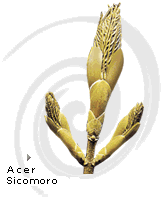 |
|
||||||||
|
|||||||||
|
 |
|
||||||||
|
|||||||||
|
 Sycamore It is a very resistant splendid tree, 35m height, with a big broad crown and a trunk up to 7m diameter. It is a very common native tree of Central and Southern Europe, which was probably introduced by the Romans in Great Britain, where it grows even in exposed mountainous places. Its buds are ovoid and greenish and the leaves, big up to 18x24 cm, generally broader than longer, with 6-12 cm petioles, they have five irregulars toothed lobes, often reddish. The flowers hang forming beautiful green-yellow tufts of 6-12 cm long, and are followed by winged seed racemes, green first, then reddish, paired arranged in 70-120°angles. The bark of the juvenile trees is plain, but the adult ones is exfoliated in quadrangular scales generally rolled by the edge leaving some beige rose-colored patches. It is an important woody tree, whose strong and whitish wood, has a beautiful natural luster, and is usually of wavy grain. In some trees the wood has wonderfully wavy marks, highly valuable and appreciated for veneer and boxes of string instruments, that is why it is often called maple tree of "violin board". The normal sycamore wood is used in cabinetwork, for kitchen utensils, furniture y turnery. It is necessary to mention the disease of black crusts that produce some black round patches with yellow edge in the sycamore leaves due to the Rhytisma acerinum fungus. There are two interesting cultivations: "Purpureum " of beautiful purple foliage and "Brillantissimun", whose leaves are first rosy and then yellowish and turn out to be very showy until mid summer when they turn green. Autochthonous habitat: Origin in gardening Cultivation: It tolerates sunny places and almost any soil. It is a smaller cultivation whose growth is slower than the specie and attractive for small gardens. Multiplication: By graft in winter or spring or by side grafting in summer. Encyclopedia BLUME, Trees, wood and forests of the world, H. Edlin/M.Nimmo, page 188. |
| 3/4/2014 5:35:15 PM |
|
| Rama Forestry Project - Estancia Rama - Provincial Route 9 Km. 72 - Valle of Pancanta -
(5701) San Luis - Argentina / TE: +54 2652 447480 / +54 2652 452000 ext 4308
rama@rama.com.ar
| |